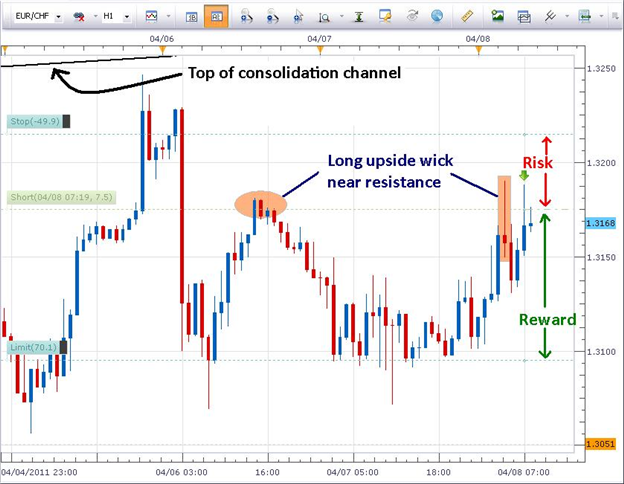Candlestick trading
Post on: 17 Май, 2015 No Comment

Heikin-Ashi Candlestick Charting
January 1, 2013 by Kori Sato
Depending on the charting package that you use, you may have been intrigued to see the name Heikin-Ashi as one of the options. Heikin-Ashi is Japanese for average bar, and the method of plotting is a way to smooth out the fluctuations that you typically see with normal candlestick charting. In use, you would need to see both charts as the Heikin-Ashi is not a substitute for a normal price chart, but simply provides a different window on the information.
The open-close-high-low prices are plotted in the same way as a regular candlestick chart, but they are calculated in a different way rather than simply being at the prices that were traded. For convenience, I’ll refer to them as the HAopen, HAclose, HAhigh, and HAlow.
The opening price HAopen is calculated from the previous day, and is the average of the previous day’s HAopen and HAclose. Basically a different description of where the price was reckoned to be by the market previously, and therefore leading into the present day.
The closing price HAclose is the average of the current bar’s OHLC, the actual trading prices for today. Once again, you can view this as a description of where the market thinks the price should be on this day, and therefore the settled closing price.
Having defined the HAopen and HAclose, the other two are easy. HAhigh is the highest of the actual high price, the HAopen and the HAclose. HAlow is the lowest of the actual low price, the HAopen and HAclose.
Incidentally, you can see that you need a Heikin-Ashi calculation of the previous day to even draw the charts properly. However, if you start with conventional values for the first day plotted, it will rapidly fall in line with the true HA values.
The result of this blending of prices is that the candles drawn are much more indicative of the trends. Here is a normal chart for BAE Systems –
Longer Term Trading with Candlesticks
December 18, 2012 by Kori Sato
You have probably heard that all of your technical analysis tools can be used on “any timescale”, and thought that this meant that your methods of trading analysis of daily charts could be applied to intraday, say 5 min. charts, if you became interested in day trading. While that is true, the “any timescale” comment also applies to longer periods, such as you should consider when investing. Heres some more trading info on longer term trading with candlesticks.
I am classifying “investors” as people who are not terribly interested in staying on top of the comings and goings of the stock market, and prefer to lodge their money in financial instruments on a long-term basis. They turn a blind eye to the ups and downs of the market from day to day, focusing instead on long-term gains. This is in their overriding belief that over the course of time and over history the stock market will always come out on top. While the nature of the market has changed, which caused some to question whether this is still a worthwhile strategy, there are many who still stand by this policy. But it is a mistake to think that any investors should only consult fundamental analysis, looking for the underlying earnings and marketing results in order to direct their portfolio.
A more sound methodology is to use fundamental analysis in your initial selection, but to consult weekly candlestick charts for any early sign of weakness. By the time weakness becomes obvious in earnings reports, it is likely that you will have lost far more than if you simply applied your candlestick charting knowledge to the weekly price chart.
Here is a weekly price chart of the Dow Jones Industrial Average. It serves to illustrate how candlestick patterns can still be found at this time scale. The arrows point to particular candlestick patterns that the charting software has located. For instance, “A” is the Hammer pattern, usually thought of as hammering out the bottom and reversing a downtrend. “B” is the Bullish Engulfing pattern, where a bullish white candlestick totally covers the real body of the previous bearish candle.
As you should expect, not all of the discovered patterns work, but it is clear that they are as effective in this context as in a daily chart. Before relying on them, you should consult other technical analysis including indicators, volume, support and resistance levels, etc. A candlestick pattern alone is simply an indication of the week’s trading, and while it is indicative of market sentiment it is no substitute for corroborating evidence.
If you decide to use candlesticks in your investment portfolio, you still have to take a longer-term view towards your money. For instance, the weekly candlestick chart will not give you an indication of a failing trend until the end of the week when you review it. Thus you might have a higher loss than if you had treated it as short-term trading, and checked for patterns each day. Nonetheless, the superior information which you can get from using candlesticks in your investing can still save you significant amounts compared with buy and hold tactics which are used by most small investors.














